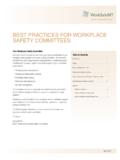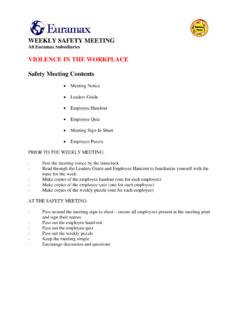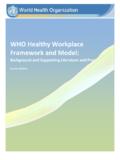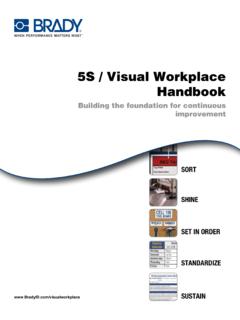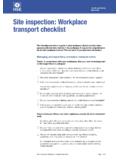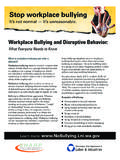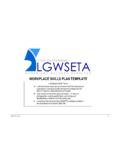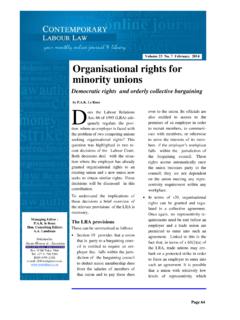Transcription of HUMAN RESOURCE PROCEDURE GUIDE …
1 HUMAN RESOURCE PROCEDURE GUIDE CONDUCTING WORKPLACE INVESTIGATIONS INTRODUCTION Inevitably, there comes a time in every employer s existence where a complaint, an accusation, alleged employee misconduct, or a rumor of something amiss comes to their attention requiring some sort of action. And occasionally a complaint may arrive through an outside agency, such as the Equal Employment Opportunity Commission, or even a lawsuit. These represent situations where an internal investigation is called for: to gather facts, sort out the details, and then finally to reach a conclusion which leads to an employment decision, a response to an agency, or to prepare a defense in a lawsuit. Well-done workplace investigations serve other purposes. For example, they can serve as a demonstration to staff that their employer is committed to objective and fair treatment of employees. PURPOSE To present an overview of the importance and benefits of, and key elements in, conducting an impartial and prompt workplace investigation.
2 SCOPE Advantages of conducting internal investigations Key elements in an effective investigation Types of Investigations Tips for interviewing witnesses Sexual Harassment investigation Special Considerations Gathering evidence Credible conclusions and recommendations PROCESS No matter how hard an employer tries to treat all employees in a fair manner, chances are a time will come when a staff member will react to an employment decision negatively and perceive that he or she was treated unjustly. In other instances an employee s supervisor may actually have injured the employee in some way or violated company policy. When an employer is faced with an internal investigation it should be done correctly and by a qualified individual. It should be remembered that investigation details and notes may be introduced in court and a sloppy or biased inquiry can actually work against the employer in a lawsuit.
3 Advantages Taking the time to conduct even a short and informal investigation offers several benefits to the employer. Self-monitoring ensures that managers, supervisors and employees are complying with employment laws, and company policies and guidelines. Avoids embarrassment by minimizing the risk of disciplining or terminating an employee for something he or she didn t do (things are not always as they seem). 7/98 Page 1 HUMAN RESOURCE PROCEDURE GUIDE CONDUCTING WORKPLACE INVESTIGATIONS PROCESS (cont d) Reduces risk of legal action. Prompt investigation and appropriate action based on factual conclusion can satisfy an otherwise hostile employee.
4 Discipline or termination based on a thorough, unbiased investigation and conclusion removes perception of unfair or unjust treatment. A prompt response and corrective action in a sexual harassment situation provides the employer with an affirmative defense. Informal vs. Formal Investigation Not all workplace investigations require a formal and comprehensive approach. Depending on the nature of the complaint, sometimes an informal and relatively quick inquiry provides all the information needed to reach a conclusion and resolution. During the initial meeting with the complaining employee all the facts and issues should be identified including who was involved, and what, when, where, why and how the incident happened. This information should assist in determining whether a formal investigation is necessary. Typically, an informal approach will usually result in resolution if the matter: Concerns misunderstanding by employee of company policy Concerns lack of communication between complaining employee and his supervisor or a co-worker Needs no other facts to resolve the issue Requires no other resources for impartial and timely resolution Is amenable to informal resolution An event that is subject to an informal investigation should be handled just as seriously and expeditiously as a more serious matter.
5 It is here that the employer can prevent an issue from playing itself out in a larger arena. Further inquiry, of a more formal nature, is usually necessary if the following criteria apply: Additional facts are needed Employee is unable to supply the investigator with those facts Others need to be interviewed Documents need to be reviewed Special expertise is required to obtain in-depth data and analysis Planning the Investigation As in all major business undertakings, it is important to take the time to lay out as many details as possible prior to interviewing your first witness or employee. Some of the assessments to be made include: What policies/guidelines apply to this situation? What is the company s obligation? 7/98 Page 2 HUMAN RESOURCE PROCEDURE GUIDE CONDUCTING WORKPLACE INVESTIGATIONS PROCESS (cont d) How have similar incidents been handled in the past?
6 Who will be interviewed and in what order? What questions will be asked? What special expertise do I need? What interim action (such as a suspension) is necessary? Does the potential for violence exist? Sexual Harassment Any and all allegations of sexual harassment should be investigated thoroughly. Employers have a legal obligation to do everything reasonable to stop the conduct. A company s liability can depend on how it handles a complaint. TOOLS AND METHODS The Right Person It is important to select someone with experience and expertise in conducting internal investigations. Particularly for formal investigations of serious charges, the individual should be skilled in setting people at ease and have the ability to draw out reticent witnesses in order to collect the facts. Additionally, the individual should be unbiased and unprejudiced and be perceived as such.
7 This should be established prior to any interview by asking a question such as: Are you comfortable that I can be impartial through this investigation? Assuming this answer is yes, the investigator should document the response. Later on, if an employee is unhappy with the resolution of the problem, he/she can not credibly claim bias. If the answer is no, then another investigator should be selected. Interviews During interviews with all affected employees and witnesses, some ground rules and basic questions should be covered. Interviewees should be: assured that no conclusion has been reached assured that no reprisal will be taken for coming forth with information required to keep all discussions confidential asked to identify anyone else with possible relevant information Interviewing the Employee Raising the Issue Establish comfort level with investigator s impartiality.
8 Identify all issues. Gather all facts. Are there relevant written documents? Did employee keep records? 7/98 Page 3 HUMAN RESOURCE PROCEDURE GUIDE CONDUCTING WORKPLACE INVESTIGATIONS TOOLS AND METHODS (cont d) Was employee s work affected? Were there witnesses? Was incident isolated or part of pattern? Has employee discussed this with anyone else? Solicit employee s suggestions for resolving the issue. Assure employee that company does not permit retaliation Assure the employee that disclosure of any information will be limited to people on a need-to-know basis.
9 Remind employee that he is expected to do the same. Ask employee to put all information in writing and sign and date it. Interviewing the Employee Who is the Subject of the Complaint Provide as many details about the issue as possible. Identify the policy or guidelines that underlie the issue. Begin with open-ended questions ( , Now that you have heard what the person who initiated this issue had to say, what can you add that will help us resolve it?) Ask the tough, unfriendly and embarrassing questions towards the end of the interview when the employee will be less on the defensive. Ask for a chronological description of events; it will assist in comparing different versions and might help resolve credibility issues later on. Avoid reaching conclusions. Keep asking questions until you feel relatively certain that you have obtained the truth. If employee claims that the accuser is lying, ask why he thinks someone would do so.
10 Documents Ask the complaining employee to write down her side of the story. This will avoid misunderstandings and ensures the investigator understands correctly all the facts. Write a confirming memo to the employee raising the issue of all key points of the meeting to ensure proper understanding of the details surrounding the complaint. Notetaking Write down only the facts; avoid interpretations, feelings, assumptions, and frustrations. Write direct quotes, if possible. Record on separate pieces of paper instead of a notebook. Notes may be subject to discovery in a lawsuit and a notebook may contain information not relevant to the issue. Assessing credibility Make notes immediately after interviewee leaves room to help you assess credibility later. Judge demeanor ( , nervousness, tone of voice, etc.), logic and consistency of story ( , does it make sense, does it agree with others, etc.)
